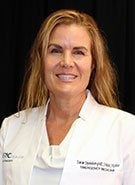Stroke: Learn the signs and how fast to act

By Sarah Spelsberg, MD, UNC Health Southeastern Emergency Medicine Resident
"How do I know if I am having a stroke, and how fast do I need to get to the emergency department?"
Understanding the answer to this question is important because recognizing the signs of a stroke and seeking immediate medical attention can make a significant difference in outcomes, including survival and quality of life. The urgency in dealing with strokes can be summed up in a simple yet vital phrase: "time is brain."
A stroke occurs when blood flow to a part of the brain is interrupted or significantly reduced, depriving brain tissue of oxygen and nutrients. This can be from a clot or a bleed. Within minutes, brain cells begin to die, leading to potential permanent damage. Therefore, the faster a stroke is identified and treated, the better the chances of minimizing brain damage and improving recovery outcomes. Rapid treatment can prevent long-term disability and, in many cases, save lives. Do not procrastinate! This is a true emergency.
One of the things we have tried to teach the public is F.A.S.T.
F.A.S.T. is an acronym used to help identify the signs of a stroke and respond quickly. It stands for:
- Face: Ask the person to smile. Check if one side of the face droops.
- Arms: Ask the person to raise both arms. See if one arm drifts downward.
- Speech: Ask the person to repeat a simple phrase. Listen for slurred or strange speech.
- Time: If you observe any of these signs, call emergency services immediately. Time is critical in treating a stroke.
When someone comes to the emergency department with stroke-like symptoms that have persisted for less than 24 hours, preferably less than six hours, they can expect us to call a “Code Stroke.” This immediately frees up the CT scan for their brain imaging and gets a neurologist specialist on a screen to interact with and evaluate. I often tell patients to not be scared or put off, but we will be utilizing a lot of resources and prioritizing your care to be as efficient as possible knowing there is a short window of time to preserve brain tissue. I also explain to patients that providers will ask when you last felt normal, start IVs, get the neurologist screen, and rush over with you to the CT Scan machine. I am sure it can be overwhelming as a patient but there are reasons why this is one time we move extra fast!
Sometimes stroke patients are candidates for thrombolysis, which is giving medicines to break up the clot, but this must be done very early in the process, it is too dangerous to give them later. Another option for stroke patients who are having something we call a “large vessel occlusion” is we transport them to another facility where a neurosurgeon can remove the clot. This is why it is so important not to wait to get evaluated for stroke-like symptoms! If a patient has waited several days, medical professionals are outside of the window where we can make a big difference in outcomes.
To recognize a stroke, remember the F.A.S.T. acronym: Face drooping, Arm weakness, Speech difficulty, and Time to call emergency services. Quick action is crucial as immediate medical attention can significantly improve outcomes. Seek help immediately if any of these symptoms are present, as timely treatment can save lives and reduce long-term damage. Providers need stroke ambassadors out there to help recognize these symptoms and encourage people to get help as fast as possible.
Dr. Spelsberg, is a second-year resident in the Emergency Medicine residency program at UNC Health Southeastern. In addition to offering services you’d expect from a community health care system, UNC Health Southeastern provides a number of specialized services that are unique to our healthcare system and not available anywhere else in the region. To schedule an appointment, call our referral line at 910-735-8864. To learn more, visit UNCHealthSE.org. To submit questions for consideration for a future Frequently Asked Questions article, email unchsoutheasterninfo@unchealth.unc.edu.